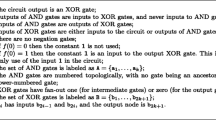Abstract
We introduce a natural set of arithmetic expressions and define the complexity class AE to consist of all those arithmetic functions (over the fieldsF 2n) that are described by these expressions. We show that AE coincides with the class of functions that are computable with constant depth and polynomial-size unbounded fan-in arithmetic circuits satisfying a natural uniformity constraint (DLOGTIME-uniformity). A 1-input and 1-output arithmetic function over the fieldsF2n may be identified with ann-input andn-output Boolean function when field elements are represented as bit strings. We prove that if some such representation is X-uniform (where X is P or DLOGTIME), then the arithmetic complexity of a function (measured with X-uniform unbounded fan-in arithmetic circuits) is identical to the Boolean complexity of this function (measured with X-uniform threshold circuits). We show the existence of a P-uniform representation and we give partial results concerning the existence of representations with more restrictive uniformity properties.
Similar content being viewed by others
References
Allender, E. W., P-Uniform Circuit Complexity.Journal of the Association for Computing Machinery,36 (1989), 912–928.
Bach, E., Driscoll, J., and Shallit, J., Factor Refinement.Journal of Algorithms,15 (1993), 199–222.
Balcázar, J. L., Diaz, J., and Gabarró, J.,Structural Complexity. Springer-Verlag, New York 1988 (Vol. 1), 1990 (Vol. 2).
Barrington, D. A. M., Immerman, N., and Straubing, H., On Uniformity Within NC1.Journal of Computer and System Sciences,41 (1990), 274–306.
Borodin, A., On Relating Time and Space to Size and Depth.SIAM Journal on Computing,6 (1977), 733–744.
Boyar, J., Frandsen, G. S., and Sturtivant, C., An Arithmetic Model of Computation Equivalent to Threshold Circuits.Theoretical Computer Science,93 (1992), 303–319.
Chandra, A. K., Stockmeyer, L., and Vishkin, U., Constant Depth Reducibility.SIAM Journal on Computing,13 (1984), 423–439.
Frandsen, G. S., Parallel Construction of Irreducible Polynomials. Technical Report DAIMI PB-358, Aarhus University, 1991.
Frandsen, G. S., and Sturtivant, C., The Depth Efficacy of Unbounded Characteristic Finite Field Arithmetic. Technical Report DAIMI PB-240, Aarhus University, 1988.
Furst, M., Saxe, J. B., and Sipser, M., Parity, Circuits, and the Polynomial Time Hierarchy.Mathematical Systems Theory, 17 (1984), 260–270.
Immerman, N., Languages that Capture Complexity Classes.SIAM Journal on Computing,16 (1987), 760–778.
Immerman, N., Expressibility and Parallel Complexity.SIAM Journal on Computing,18 (1989), 625–638.
Jungnickel, D., Menezes, A. J., and Vanstone, S. A., On the Number of Self-Dual Bases of GF(qm) over GF(qm).Proceedings of the American Mathematical Society,109 (1990), 23–29.
Lempel, A., Matrix Factorization over GF(2) and Trace-Orthogonal Bases of GF(2n).SIAM Journal on Computing,4 (1975), 175–186.
Lempel, A., and Weinberger, M. J., Self-Complementary Normal Bases in Finite Fields.SIAM Journal on Discrete Mathematics,1 (1988), 193–198.
Lenstra, Jr., H. W., Finding Isomorphisms Between Finite Fields.Mathematics of Computation,56 (1991), 329–347.
Lidl, R., and Niederreiter, H.,Finite Fields. Encyclopedia of Mathematics and Its Applications, Vol. 20. Addison-Wesley, Reading, MA, 1983.
Lüneburg, H.,On a Little but Useful Algorithm. Lecture Notes in Computer Science, Vol. 229. Springer-Verlag, Berlin, 1985, pp. 296–301.
Muroga, S.,Threshold Logic and Its Applications. Wiley/Interscience, New York, 1971.
Ruzzo, W. L., On Uniform Circuit Complexity.Journal of Computer and System Sciences,22 (1981), 365–383.
Seroussi, G., and Lempel, A., Factorization of Symmetric Matrices and Trace-Orthogonal Bases in Finite Fields.SIAM Journal on Computing,9 (1980), 758–767.
Shoup, V., New Algorithms for finding Irreducible Polynomials over Finite Fields.Mathematics of Computation,54 (1990), 435–447.
Skyum, S., and Valiant, L. G., A Complexity Theory Based on Boolean Algebra.Journal of the Association for Computing Machinery,32 (1985), 484–502.
Author information
Authors and Affiliations
Additional information
The research of G. S. Frandsen was partially carried out while visiting Dartmouth College, New Hampshire. He was partially supported by the Danish Natural Science Research Council (Grant No. 11-7991) and by the ESPRIT II Basic Research Actions Program of the EC under Contract No. 3075 (project ALCOM). D. A. M. Barrington's research was supported by NSF Computer and Computation Theory Grant CCR-8714714.
Rights and permissions
About this article
Cite this article
Frandsen, G.S., Valence, M. & Mix Barrington, D.A. Some results on uniform arithmetic circuit complexity. Math. Systems Theory 27, 105–124 (1994). https://doi.org/10.1007/BF01195199
Received:
Revised:
Accepted:
Issue Date:
DOI: https://doi.org/10.1007/BF01195199




